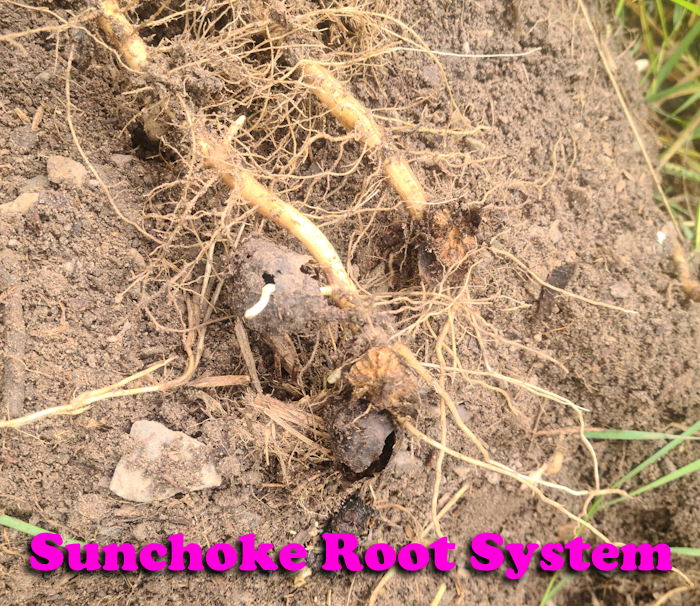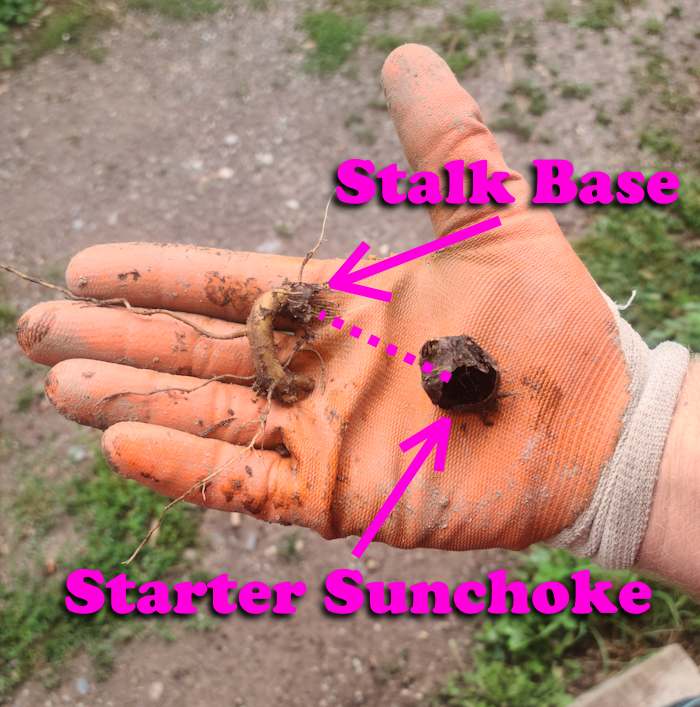
 4
4




 4
4




Douglas Alpenstock wrote:Hey all, a while back I smuggled some sunchokes on the plane from British Columbia. This is a variety I have eaten and they were lovely. They are now stretching like mad in giant plant pots.
Will they survive/thrive if I plant them deep on a sunny slope and use cardboard and mulch to suppress the brome grass that currently dominates? They aren't going to get a lot of TLC -- but that's kinda the point.
I'd appreciate any wisdom you can give. I'm the new guy here.
$10.00 is a donation. $1,000 is an investment, $1,000,000 is a purchase.

 3
3




 6
6




Christopher Weeks wrote:They grow in my northern Minnesota sand, but I don't get the bumper crops that I see others harvesting online.

 5
5




Working toward a permaculture-strong retirement near sunny Sperling.
 5
5




Derek Thille wrote:Considering they do well at Wheaton Labs near Missoula, MT and we have them growing here (some have started to market them commercially as well) in southern MB, you should certainly be able to grow them. We have pretty heavy soil here, so they aren't likely to be as nice and abundant as some others experience, but I have lots of space to fill, so I don't mind if they simply form patches that show their lovely yellow flowers.
$10.00 is a donation. $1,000 is an investment, $1,000,000 is a purchase.











 3
3




Cécile Stelzer Johnson wrote:
Derek Thille wrote:Considering they do well at Wheaton Labs near Missoula, MT and we have them growing here (some have started to market them commercially as well) in southern MB, you should certainly be able to grow them. We have pretty heavy soil here, so they aren't likely to be as nice and abundant as some others experience, but I have lots of space to fill, so I don't mind if they simply form patches that show their lovely yellow flowers.
Towards the end of the season, sunchokes do make beautiful, tiny sunflowers, but those never seem to make seeds, unfortunately.
Another use for these bountiful tubers is fodder for pigs, chickens, goats. etc. [After harvest, I select any tuber that is too tiny, was damaged by the spade [I use my hands & sometimes a fork] to give to my chickens. The rest, I store in homer buckets with damp sand, in an unheated garage, to eat and for seed next year.
Right around deer hunting -don't tell the warden- some damaged ones will find their way on a deer trail. They are grateful, then we are grateful for sunchokes [Helianthus tuberosus]
You could also just grow it as a dense wind barrier if your area is windy, but I prefer to use sunflowers (Helianthus annuus) which, as the name indicates is an annual, for that: There is a variety that is very large and tall [I'm talking about one that has stems the size of my wrist!! and is nearly 10 ft.]. Also, the sunflowers will give you seeds, whereas sunchokes don't for short season areas. These tall sunflowers, if left undisturbed will leave a tall erect barrier on which you could grow vines to fill gaps and make an even better wind barrier. I'm saying that because I heard that Southern Manitoba is quite windy.
Wink wink.
Working toward a permaculture-strong retirement near sunny Sperling.
 10
10




Gardens in my mind never need water
Castles in the air never have a wet basement
Well made buildings are fractal -- equally intelligent design at every level of detail.
Bright sparks remind others that they too can dance
What I am looking for is looking for me too!

 3
3




Cécile Stelzer Johnson wrote:Hi, Douglas. So Alberta, Saskatchewan and Manitoba? They grow very well in my sandbox [central WI zone 4b] and will survive even lower temps than indicated [like -40F] and come back for an encore year after year, provided the deer don't nibble on them too much in the baby stage.
You don't tell us what kind of soil you have. ...
It helps to keep them bound: When the growing root encounters an obstacle, that's where the tuber starts forming. I have mine in beds for that reason.
 5
5




Christopher Weeks wrote:They grow in my northern Minnesota sand, but I don't get the bumper crops that I see others harvesting online.




 8
8




Douglas Alpenstock wrote:
Cécile Stelzer Johnson wrote:Hi, Douglas. So Alberta, Saskatchewan and Manitoba? They grow very well in my sandbox [central WI zone 4b] and will survive even lower temps than indicated [like -40F] and come back for an encore year after year, provided the deer don't nibble on them too much in the baby stage.
You don't tell us what kind of soil you have. ...
It helps to keep them bound: When the growing root encounters an obstacle, that's where the tuber starts forming. I have mine in beds for that reason.
Excellent information -- just what I'm looking for. Thank you!
Our "soil" is a fine silty sand mix. But I'm holding them in 16w x 12+d tree pots I scrounged, with a mix of compost, char, and half-digested wood chips. They clearly love it! I have eight vigorous tubers, and I can get more.
If they like to be bound, I can adjust that to one plant per pot and plunk them deep into the ground, flush with the soil surface. And then we'll see!
BTW, would they be fussy about well water that is somewhat alkaline (basic) -- high TDS? My captured rain water is precious stuff.
$10.00 is a donation. $1,000 is an investment, $1,000,000 is a purchase.
 9
9




"We carry a new world here, in our hearts..." --Buenaventura Durruti
"Don't wish it were easier. Instead, wish you were better." --Jim Rohn
 5
5




Stephen B. Thomas wrote:Some notes on harvesting sunchokes throughout the year.
They can be harvested while buried in snow. In Montana, that means late December through March. They are intact and fresh. Some folks report a sweeter taste and less "comedy" (intestinal gas) for those that have over-wintered.
We've observed that the tubers begin softening and shriveling-up starting in early- to mid-June. You might be able to dig around and find some more that are still in edible condition if you find large, dry stalks at that time of year (over 1" / 3cm diameter). Everything else seems to be making new stalks, and that's where all the stored energy is going.
We will be checking to see how early we can harvest them. But in general, typical harvests begin after the flowers are gone, and the stalks are drying up. In our case, that typically means mid-October.
Western Montana's sunchoke harvesting season: late October to mid-June.
$10.00 is a donation. $1,000 is an investment, $1,000,000 is a purchase.
 10
10




Try Linux on your computer, free, no virus worries, stable and maintenance free. Distributions I recommend are Linux-Mint and Debian. Better than throwing your PC away when Windows rejects you.
 4
4




Cécile Stelzer Johnson wrote:16" wide by 12" deep is nowhere near enough soil for these vigorous growers.
I've put them in beds [4'X8'] so with no bottoms. That's how I know they can go deeeep, ...
 8
8




Try Linux on your computer, free, no virus worries, stable and maintenance free. Distributions I recommend are Linux-Mint and Debian. Better than throwing your PC away when Windows rejects you.
 6
6




Douglas Alpenstock wrote:
Cécile Stelzer Johnson wrote:16" wide by 12" deep is nowhere near enough soil for these vigorous growers.
I've put them in beds [4'X8'] so with no bottoms. That's how I know they can go deeeep, ...
I appreciate the advice. I will dig a trench then, with some amending to increase water retention and nutrients. Maybe I can line the trench walls with junk wood to irritate them into producing new tubers. How close together would you plant them?
$10.00 is a donation. $1,000 is an investment, $1,000,000 is a purchase.
 6
6




 5
5




J Katrak wrote:I planted 2 different kinds on July 15th and July 16th. Zone 4b WI, in the ground. Zone 4b MN, in containers.
One is Red Fuseau and the other I don't know but more yellow, not very knobby.
It's pretty late to get a harvest this year but I just couldn't wait until spring.
I planted some 20 years or so ago and I can't even remember exactly where. I know I harvested and ate some. I suspect I read about them being "invasive" and made sure to eradicate with a tiller. I have other sunflowers growing I suspect could be wild ones. they will only really grow if fenced or the deer will eat them to the ground. I'll dig some of those this fall and see if there are any tubers.
$10.00 is a donation. $1,000 is an investment, $1,000,000 is a purchase.
 5
5




 4
4







"We carry a new world here, in our hearts..." --Buenaventura Durruti
"Don't wish it were easier. Instead, wish you were better." --Jim Rohn
 6
6




Stephen B. Thomas wrote:Some mid-summer observations about sunchokes. Paul wanted to take a number of tubers out to a potluck event so that others could plant them, so I chose about a dozen plants to dig up and then documented what I noticed.
These are from 1st August, and I don't recommend trying to harvest round this time since the tubers are so tiny. Most of the energy stored in the original tuber seems to have gone up to fortify the stalk. I am still unclear as to what is the best set of conditions for sunchokes: focusing on access to water, or soil, etc. Which is the most-impactful lever to adjust...? I don't have an answer just yet.
$10.00 is a donation. $1,000 is an investment, $1,000,000 is a purchase.












 5
5




 7
7




Christopher Weeks wrote:This is my second patch of sunchokes. They were planted late fall of 2023. It's 2/3 Lofthouse sunchokes and 1/3 mixed others. I only harvested a few around the back right (in this picture) edge last fall. Last year they grew fewer plants, but each seemed more vigorous -- thicker stalks, taller, more flowers.
What happens to a patch that you don't harvest? Once? After years? And what's the yield like after neglect? I'm trying to gauge how important it is to disrupt the whole patch.
And if you don't have especially friable soil, how do you harvest at a reasonable speed? I find this takes hours of hard work to get relatively few. I have a half inch of soil, eight inches of sand(y loam), and then dozens of feet of sand and rocks that have compacted somehow even without much clay.












 3
3





|
A wop bop a lu bob a womp bam boom. Tutti frutti ad:
The new gardening playing cards kickstarter is now live!
https://www.kickstarter.com/projects/paulwheaton/garden-cards
|





.jpg)
